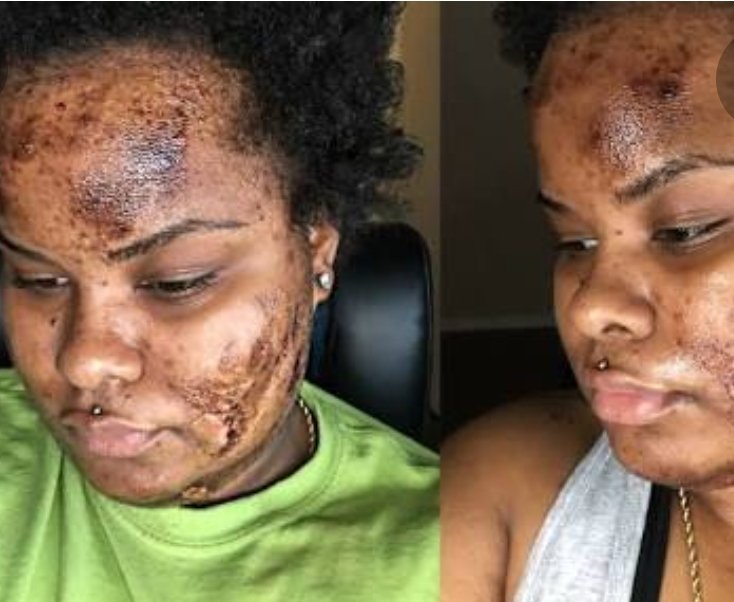1. #dermatologyteaching A long read.
Let& #39;s talk about procedures for the dark skin with a focus on chemical peels.
There are several aesthetic/skin rejuvenation procedures that are done either to improve texture and appearance of the skin following sun damage, hyperpigmentation
Let& #39;s talk about procedures for the dark skin with a focus on chemical peels.
There are several aesthetic/skin rejuvenation procedures that are done either to improve texture and appearance of the skin following sun damage, hyperpigmentation
2. Or following skin conditions like acne. Sometimes, these procedures are done periodically just to improve the appearance of the skin. Know that all the procedures mentioned are aimed at stimulating new epidermal growth (top layer of the skin)
3. And a more orderly arrangement of the collagen in the skin (collagen is in the dermis which is the deeper layer of the skin and it gives the skin the supple look and tensile strength)
4. For the purpose this discussion, let& #39;s classify them into the chemical or mechanical rejuvenation procedures.
Chemical peels are the procedures in the former. In the latter, procedures like microdermabrasion, microneedling, LASER resurfacing are in this group.
Chemical peels are the procedures in the former. In the latter, procedures like microdermabrasion, microneedling, LASER resurfacing are in this group.
5. A chemical peel as the name implies is the process of using certain chemicals to create intentional injury on the skin with the aim of stimulating new epidermal growth and a better arranged collagen.
6. The mechanical procedures mentioned above also do the same thing but using certain devices to mechanically stimulate this. For a microdermabrasion, think of the device as some sort of sandpaper. For a microneedling, think of a device that has small needles which
7. can be adjusted to different depths to create the injury so that uniform healing can take place with newer and brighter skin. Compounds like hyaluronic acid, vitamin C or even platelet rich plasma can be applied during this procedure to further rejuvenate the skin.
8. Back to a chemical peel...depending on the depth of peeling, they are classified into superficial (just the epidermis peeling), medium depth (up to the first part of the second layer called dermis) or deep peels (up to the 2nd layer of the dermis).
9. The most important thing to know as a black patient is that the deeper the peel,the more the risk of post procedure darkening of the skin called post inflammatory hyperpigmentation. As such, only superficial and sometimes medium depth peel can be safely used in black patients
10. It is important to know that a pre and post peel preparation is as important as the peel as they determine the outcome of the peel. Your doctor or aesthetician will ask you to use some creams prior to prepare the skin and liberal sunscreen use is important at all stages.
11. Examples of superficial peels include; 20-30% salicylic acid(a beta hydroxyacid), 30- 50% glycolic acid(an alpha hydroxyacid), lactic acid, mandelic acid, jessner solution. You will likely experience some stinging and slight pain during the peel itself followed by redness
12. And tightening on the face (or other areas treated). This is followed by actual peeling of the skin over 3 to 5 days before it starts to go back to normal. Please let the skin peel off itself.
13. Don& #39;t attempt to manually peel it off as it increases the risk of post inflammatory hyperpigmentation.
A minimum of two weeks interval is needed between peels. A single session of peel is not significant to give the desired effect.
A minimum of two weeks interval is needed between peels. A single session of peel is not significant to give the desired effect.
14. The effect of a chemical peel or any of this rejuvenation is felt even way long after the peel as new collagen is being laid down in the skin.
The most worrisome side effects as mentioned before is a rebound hyperpigmentation especially if adequate preparation is not done.
The most worrisome side effects as mentioned before is a rebound hyperpigmentation especially if adequate preparation is not done.
15. Others include formation of scars in susceptible people. Please don& #39;t do a peel while pregnant or if you& #39;re sensitive to some compounds in the peel e.g one will be careful with salicylic acid in anyone that has aspirin toxicity.
16. P.S. Acne is a manageable condition and most times not curable as breakouts may come even after treatment. Chemical peels are no guarantee that your breakouts are gone forever. But your skin appearance will definitely improve.
17. Just thought I& #39;d mention that before you get angry at the doctor or aesthetician.
Don& #39;t attempt professional peels at home on yourself if you& #39;re not a trained aesthetician or doctor. It usually doesn& #39;t end well.
Don& #39;t attempt professional peels at home on yourself if you& #39;re not a trained aesthetician or doctor. It usually doesn& #39;t end well.
18. Dear doctor, aesthetics is one aspect that proper counseling, management of expectations (especially those patients with the grandiose ones) and informed consent is crucial. Don& #39;t ever forget that please. Managing the patient& #39;s expectations are crucial to the outcome.
19. Educate your patients that if a real scar has formed with scar tissue laid down, most of these procedures will only make it look better but will not take it away completely. Note that hyperpigmentation are not scars.
20. Remember, to fail to prepare a patient& #39;s skin prior to or after a peel is tantamount to preparing the peel to fail with more adverse effects.
Picture from Google images
Questions will be answered on the thread later.
Picture from Google images
Questions will be answered on the thread later.

 Read on Twitter
Read on Twitter


